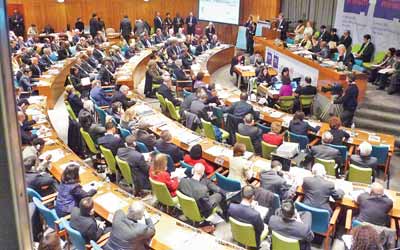|

The Donors Conference meeting in the Trusteeship Council. Over 150
nations and international organizations pledged $5.3 billion in aid to
Haiti over the next 18 months
In other words, the U.S. and
other “agricultural powers” would
provide Haiti food, “freeing up” Haitian
farmers to go work in U.S.-owned
sweatshops, thereby ushering in “an
industrial era,” as if the cinder-block
shells of assembly plants represented
organic industrialization.
Now Clinton, sensitive to the
demands of Montas’s “focus groups,”
promotes agriculture, but as a way to
integrate Haiti into the global capitalist
economy. Many peasant and anti-neoliberal
groups see agricultural self sufficiency as a way to disconnect and
insulate Haiti from predatory capitalist
powers.
At a 5:30 p.m. closing press
conference, Ban Ki-moon announced
pledges of $5.3 billion in reconstruction
aid for the next 18 months, exceeding
the Haitian government’s request
of $3.9 billion. The total pledges
amount to $9.9 billion for the next 3
years “plus” – a significant detail given
how notoriously neglected UN aid
promises are. Bill Clinton announced
that only 30% of his previous fundraising
pledge drive for Haiti had been
honored.
Haitian Prime Minister Jean Max
Bellerive and President Préval played
only supporting roles at the Conference,
requesting support at the start
and thanking nations at the end.
The essence of this conference
was summed up by Hillary Clinton.
“The leaders of Haiti must take responsibility
for their country’s reconstruction,”
said Hillary Clinton as
Washington pledged $1.15 billion for
Haiti’s long-term reconstruction. “And
we in the global community must also
do things differently. It will be tempting
to fall back on old habits – to
work around the government rather
than to work with them as partners,
or to fund a scattered array of well-meaning
projects rather than making
the deeper, long-term investments
that Haiti needs now.”
So now, supposedly, NGOs will
take a back seat to the Haitian government,
but a Haitian government which
is working with the NGOs and under
the complete supervision of foreign
“donors.” The World Bank distributes
the reconstruction funds to projects it
deems worthy. An Interim Commission
for the Recovery of Haiti (IHRC),
composed of 13 foreigners and 7 Haitians,
approves the disbursements.
Then another group of foreigners supervises
the Haitian government’s
implementation of the project.
The only direct support the
Haitian government got at the Donors
Conference was $350 million to
pay state salaries, only 6.6% of the
$5.3 billion anticipated in the next 18
months. This came after the International
Monetary Fund warned that the
budget support was necessary to keep
the Haitian government from printing
money, thereby risking inflation.
“We trust that the numerous
promises heard will be converted into
action, that Haiti’s independence and
sovereignty will be respected and ennobled,
that the government of President
René Préval and Prime Minister
Jean Max Bellerive will be facilitated
to exercise all its faculties, and that it
will be able to benefit, not the white
and foreign companies, but the Haitian
people, especially the poorest,”
said Cuba’s Foreign Minister Bruno Rodríguez Parilla at the conference.
“Generosity and political will is
needed. Also needed is the unity of
that country instead of its division
into market shares and dubious
charitable projects.”
Indeed, there are some interesting
ideas in the Haitian government’s
Action Plan, also presented at
the conference. It calls for 400,000
people to be employed, half by the
government and half by “international
and national stakeholders,”
to restore irrigation systems and farm
tracks, to develop watersheds (reforestation,
setting up pastureland, correcting
ravines in peri-urban areas, fruit
trees), to maintain roads, and to work
on “minor community-based infrastructure
(tracks, paths, footbridges,
shops and community centers, small
reservoirs and feed pipes, etc.) and
urban infrastructure (roadway paving,
squares, drainage network cleaning)
... and do projects related to the
cleaning and recycling of materials
created by the collapse of buildings in
the areas most affected by the earthquake.”
All that sounds nice, but unfortunately,
now the decision is up to the
strategists at the World Bank. |